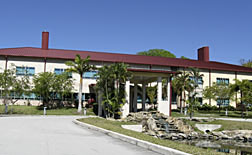This page has been archived and is being provided for reference purposes only. The page is no longer being updated, and therefore, links on the page may be invalid.
|
|
|
|
|
|
USDA Dedicates New Miami Research Building, Offers Public Tours
By Dennis O'BrienApril 8, 2010
Officials with the U.S. Department of Agriculture’s Agricultural Research Service (ARS) today dedicated a new research and administrative building at the agency’s Subtropical Horticulture Research Station (SHRS) south of Coral Gables. The new building serves as an integral part of the research station mission, housing laboratories and offices for scientists, as well as business and support staff. ARS is USDA’s chief intramural scientific research agency.
“The Miami research center has been a key player in protecting and preserving tropical and subtropical crops such as mangos, avocados, bananas and cacao that are not only very popular with consumers, but also are an important source of income to small farmers in many parts of the world,” said Molly Jahn, USDA Acting Under Secretary for Research, Education and Economics. “This new facility will help us continue that vital research and learn more about the genetic diversity of these crops, the diseases and pests that threaten them, and ways we can produce them in a more sustainable, environmentally friendly manner.”
Jahn and Edward B. Knipling, ARS administrator, attended the dedication along with numerous scientists, Miami area officials and research collaborators.
The new building completes the long-term restoration at the research center to repair damage resulting from Hurricane Andrew in 1992. Construction of the new building was supported by an $8 million Congressional appropriation.
The SHRS facilities include a USDA National Germplasm Repository that houses unique collections of cacao, mango, avocado, banana, plantains, palms, sugarcane, ornamentals, and other tropical and subtropical crops. Researchers use the collections to study the genetic diversity of various crops and look for ways to increase crop yields and make them more resistant to diseases and pathogens. SHRS researchers also focus on developing methods to control exotic insect pests and develop technologies that will save water, reduce agricultural runoff and promote sustainable agronomic systems.
The station was established in 1898 for the study of tropical plants that were being introduced into the United States. The facilities were relocated to the present site, the former Chapman Airfield in Palmetto Bay, in 1923. Because of its proximity to Biscayne Bay, the station is one of the few locations in the continental United States that can sustain long term production of tropical plants.
On Saturday, April 10, guided tours of the 204-acre grounds and the new building will be available to the public from 10 a.m. to 2 p.m. The tours will focus on the five research areas covered by SHRS scientists—plant science, agronomy, entomology, ornamental plants and cacao—and will include demonstrations of molecular genetics methods, remote sensing and water usage, and insect detection systems. Biographical sketches of the SHRS scientists and an oral history of the station will be presented in video form in the new conference room.
For further information, call (786) 573-7056 or visit the SHRS website.


